The garlic family, scientifically known as Alliaceae, is a plant family that includes several well-known and widely cultivated species. The most prominent member of this family is Allium sativum, commonly known as garlic.
Garlic is a nutritious and healthy vegetable that is used all over the world for centuries to make food delicious. Growing garlic is very simple, it can even be grown in the home garden. We will briefly explain garlic growing stages based on four years of experience which will surely help you grow garlic. This crop is a profitable crop that can give good earning.
Table Of Content
Garlic Growing Stages
In this article several garlic growing stages are described. To get a good yield from garlic cultivation, there are small things to be taken care of, which you can learn from an experienced garlic grower. So you have come to the right place. After following all the garlic growing stages, you can easily grow garlic on your land.
Garlic Varieties
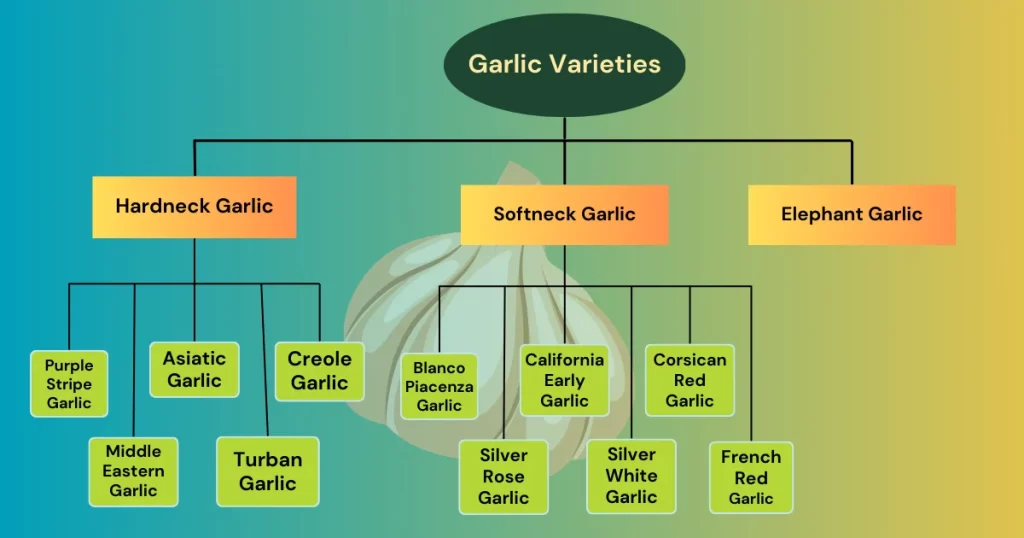
There are many varieties of garlic based on productivity and bulb size. If we want to get a good yield then it is important to select a good variety of garlic before cultivation, for that we should have knowledge about the varieties of garlic. There are different types of garlic. Some types of garlic have 4-6 cloves inside a bulb, and some types have 15–18 cloves. Some types of garlic have a red bulb, and some types have a white bulb. Not only this, but these types also differ from each other in taste.
“A good beginning makes a good ending”
Seed selection is the most important in garlic growing stages. Always healthy seeds will be selected for garlic cultivation. Healthy seeds will produce healthy plants which will lead to good yield. While using weak seed the yield will be greatly affected.
The cultivation time of each garlic variety is different according to the temperature of the region. Therefore, we have to cultivate the type of garlic that is compatible with the temperature and environment of our region to avoid blunders during the garlic-growing stages and get a good yield.
There are three types of garlic:
- Hardneck garlic
- Softneck garlic
- Elephant Garlic
1. Hardneck garlic
Hardneck garlic (Allium sativum var. ophioscorodon) is a distinct and flavorful variety of garlic that is renowned for its robust taste and unique characteristics. During Hard-neck garlic growing stages it goes through the process of vernalization, which is growing a plant in the coldest weather for at least 40 days at 40 degrees Fahrenheit or less. This process is called vernalization.
That’s why hardneck varieties are the best option for northern gardeners. They have a woody central stalk, also known as a “scape,” which emerges from the bulb and produces flower buds. This scape is often curled and can be harvested for culinary use before flowering. Hardneck garlic has a shorter shelf life; it only lasts from 3 to 5 months in storage after harvesting.
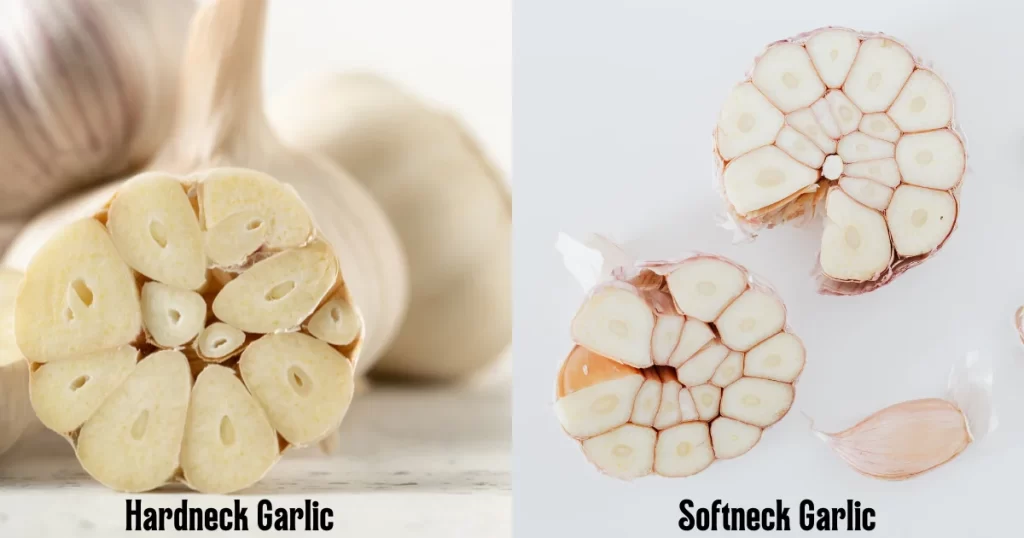
Following are some Hardneck Garlic varieties:
- Purple Stripe Garlic
- Middle Eastern Garlic
- Asiatic Garlic
- Turban Garlic
- Creole Garlic
Here are some key features and aspects of hardneck garlic:
- Flavor Profile: Hardneck garlic is prized for its bold and complex flavor. Its taste is often described as rich, spicy, and more intense compared to softneck varieties. The cloves tend to be larger.
- Growing Conditions: Hardneck garlic typically thrives in cooler climates with cold winters and warm summers. It requires well-drained soil and benefits from full-sun exposure. Planting usually occurs in the fall, and the garlic bulbs are harvested in late spring or early summer, depending on the variety and location.
- Bulb and Clove Characteristics: The bulbs of hardneck garlic are composed of multiple cloves arranged in a circular pattern. The outer layers of the bulb are generally easy to peel, revealing the individual cloves within. The cloves are larger than those of softneck garlic, and their colors can range from white to purple, depending on the variety.
- Storage and Shelf Life: Hardneck garlic has a shorter shelf life compared to softneck garlic due to its higher moisture content. It is best stored in a cool, dark, and well-ventilated place. Some enthusiasts argue that the superior flavor of hardneck garlic justifies its shorter storage life, encouraging a more immediate and frequent use in cooking.
- Culinary Uses: Hardneck garlic is a favorite ingredient in various cuisines around the world. It can be used in both raw and cooked forms, adding depth and character to dishes. The garlic scape, when harvested before flowering, is often used in pestos, sauces, and stir-fries.
2. Softneck Garlic
Softneck garlic, scientifically known as Allium sativum var. sativum, is a popular and widely cultivated variety of garlic characterized by its flexible, pliable neck and a higher number of cloves compared to hardneck garlic. Belonging to the Alliaceae family, softneck garlic is a versatile culinary ingredient with a rich history of culinary and medicinal use.
following are some Softneck Garlic varieties:
- Blanco Piacenza Garlic
- Silver Rose Garlic
- California Early Garlic
- Silver White Garlic
- Corsican Red Garlic
- French Red Garlic
- Appearance: Softneck garlic bulbs typically have a soft, papery covering and lack the rigid central stalk found in hardneck varieties. The bulbs are usually composed of multiple layers of cloves arranged in a circular fashion.
- Flavor Profile: Softneck garlic is known for its milder and more subdued flavor compared to hardneck varieties. It has a well-balanced taste that is often described as slightly sweet with less heat, making it a favorite in various culinary applications.
- Culinary Uses: Softneck garlic is a versatile ingredient in the kitchen, commonly used in a wide range of culinary dishes. It adds depth of flavor to savory dishes, sauces, dressings, and marinades. The higher number of smaller cloves in softneck garlic bulbs makes it convenient for various recipes.
- Storage and Shelf Life: Softneck garlic tends to have a longer shelf life compared to hardneck varieties. Its pliable neck allows for easy braiding, a traditional method of storage that not only enhances the garlic’s aesthetic appeal but also helps improve its longevity.
- Cultivation: Softneck garlic is well-suited for a variety of climates and is often preferred by gardeners for its adaptability. It can be grown in a range of soil types, and its flexibility makes it suitable for braiding and hanging. Softneck garlic is typically the preferred choice for commercial cultivation due to its longer storage life.
- Adaptability: This garlic variety is known for its adaptability to different growing conditions. It can thrive in diverse climates, from mild to hot, and is cultivated in various regions worldwide. Softneck garlic varieties are often preferred by growers who seek reliable yields and ease of cultivation.
- Culinary Tradition: Softneck garlic has a long history of culinary use, dating back centuries. It has been a staple ingredient in many cuisines, contributing to the distinctive flavors of Mediterranean, Asian, and Middle Eastern dishes
Difference Between Hardneck Garlic and Softneck Garlic
| Characteristic | Hardneck Garlic | Softneck Garlic |
|---|---|---|
| Stem (Neck) Type | Hard central stem | Soft, pliable stem |
| Cloves per Bulb | Fewer, larger cloves | More, smaller cloves |
| Flavor | Robust, complex | Mild, mellow |
| Storage | Shorter shelf life | Longer shelf life |
| Growing Zones | Colder climates | Warmer climates |
| Harvest Time | Earlier in the season | Later in the season |
| Scape Formation | Produces scapes | Rarely produces scapes |
| Bulb Shape | Typically bulbous | Can be bulbous or not |
| Popular Varieties | Rocambole, Porcelain | Artichoke, Silverskin |
3. Elephant Garlic
Elephant garlic is related to leeks. Elephant garlic is recognized by its name. Its bulbs are very large. In fresh condition, one bulb can be up to 500 grams. There are only 7 to 9 cloves inside a bulb. Its size and shelf life separate it from other garlics. Its excellent shelf life can keep it in the kitchen for up to 2 years. After 9 months of hard work, this variety is harvested. While normal garlic would be ready in 6 months.
Selection of land for Garlic
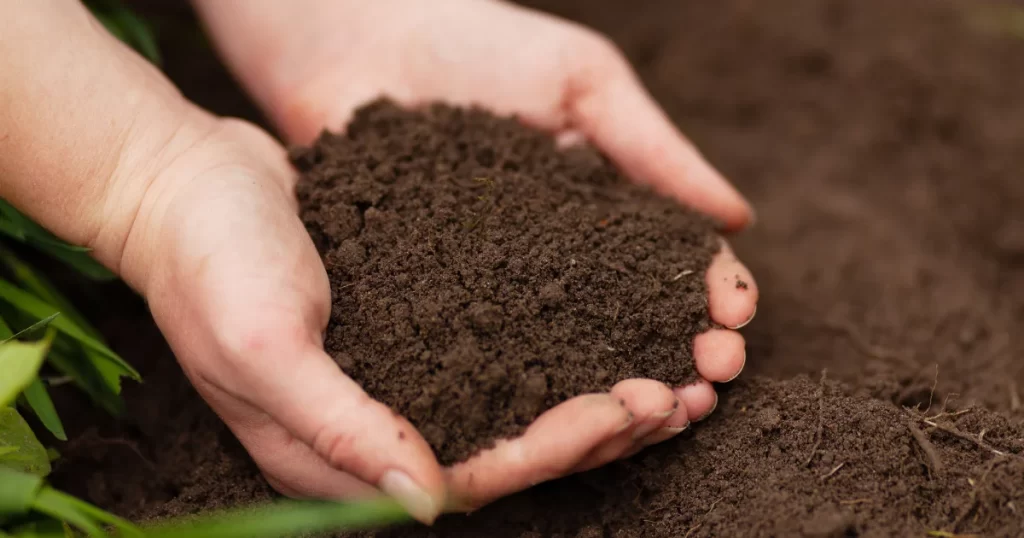
After selecting seed, it is very important to select good land to get a good yield of garlic with less effort during the garlic growing stages. The best soil for garlic is one with a pH of 6.0 to 7.0. Soft soil is best for garlic because it absorbs water within 10 to 12 hours after irrigation; soil that does not absorb water quickly, or ” hard soil,” is harmful to garlic growth.
It can affect the size of garlic bulbs, which does not increase due to prolonged standing water in the soil. It also causes garlic fungal diseases and the yellowing of the garlic leaves. Just like hard soil, sandy soil is also not suitable for garlic.
For a home garden, compost soil is ideal for planting garlic.
Note: Sunshine is very important for good growth of garlic so it is important don’t plant garlic in shade.
Land Preparation
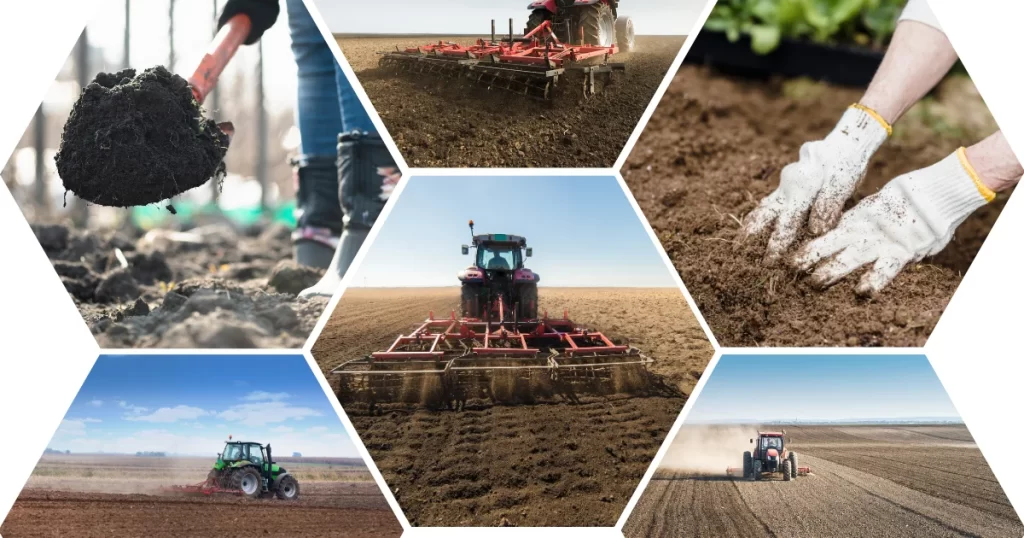
For a good yield of garlic, land preparation is very vital. To plant garlic easily, the soil of the land should be subtle, for that usually plowing and a rotavator are used. Soft soil will allow garlic roots to go deeper and receive more nutrients, sometimes it helps cultivators to use less artificial nutrients during garlic growing stages as it keeps garlic roots healthy.
Garlic Sowing
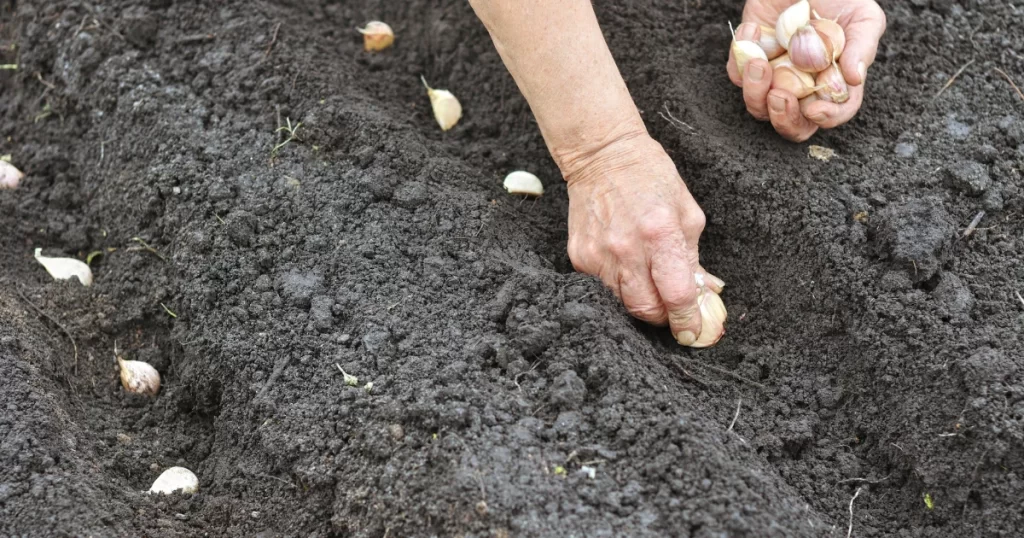
Fall or spring both seasons are suitable for sown garlic crops. Generally, it will be good for garlic to be sown in the fall when the climate is cold, and for warmer climates, it should be sown in spring. garlic requires a cold temperature of at least 40 degrees Fahrenheit for about four to eight weeks so It is necessary to sow garlic according to the climate of the region.
It is good for garlic to be sown about four to six weeks before the ground freezes because it requires time to start its flower formation and strong roots so that garlic will be able to protect its growth from cold weather.
There are different ways to plant garlic, we will discuss few of them:
1). Cultivation by Planter Bed
2). Cultivation on Flat Land
Cultivation by Planter Bed
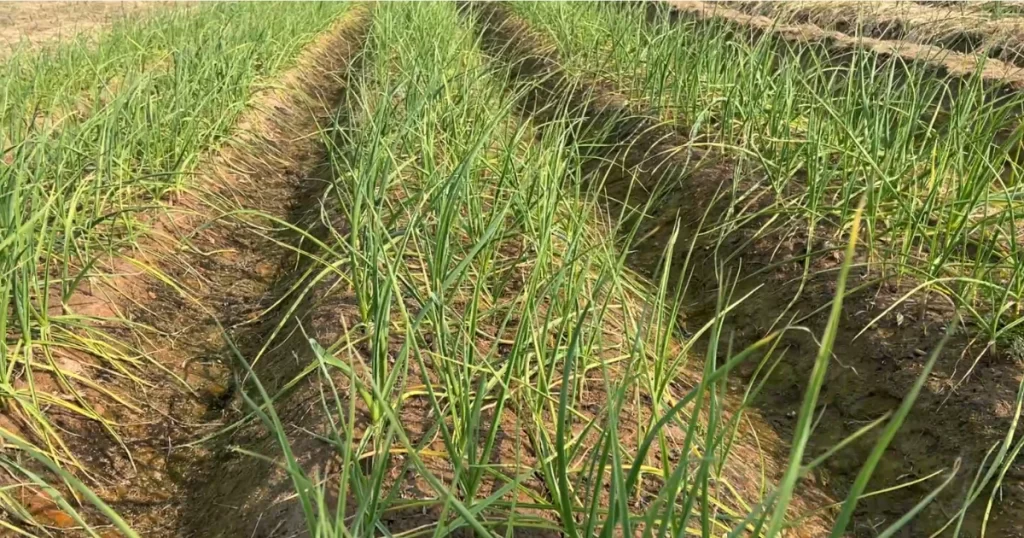
The most modern method of planting garlic is on a planter bed. It is very suitable for large-scale cultivation of garlic. As it comprises of less challenges during garlic growing stages, so in this method cultivation and harvesting of garlic is done easily and quickly.
In this method, a bed of 24 inches and 32 inches can be made. The 24-inch bed is preferred as it allows moisturization to reach the top of the bed easily. 6 rows of garlic are applied over a 24-inch bed. The garlic cloves are planted 4 inches wide and 6 inches long across the top of the planter bed. It provides sufficient space due to which more plants are cultivated in the land. if a 32-inch bed is made then the bed should be watered slowly so that moisturization vapor reaches the entire bed.
Cultivation on Flat land
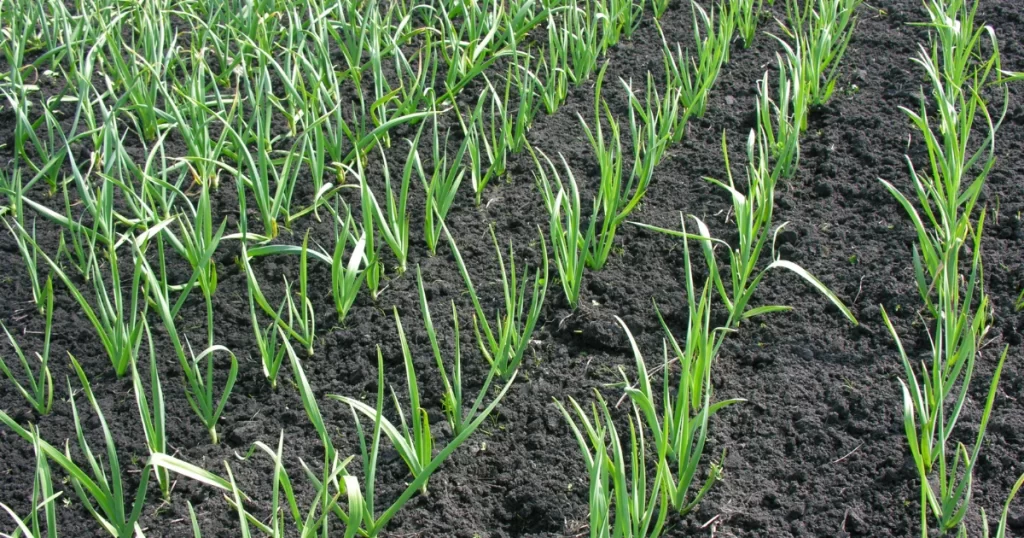
This method is the oldest and most traditional method. The same method is adopted to cultivate garlic in a small area or in the home garden. By cultivating garlic on flat land we can plant more number of plants in a small area. Plant garlic cloves 4 to 6 inches apart, keeping rows 8 to 10 inches apart. After planting the garlic cloves, water them.
Garlic Mulching
Mulching on garlic has many benefits. By mulching, we not only prevent weeds but also provide a perfect environment for the garlic plants. By applying less water with mulching we can keep the best moisturization in the soil which is very suitable for garlic. By mulching, we keep the garlic free from weeds organically. Weeding by spraying is not suitable for the good growth of garlic crops. During the garlic growing stages after the first irrigation, mulching is done over the garlic cloves.
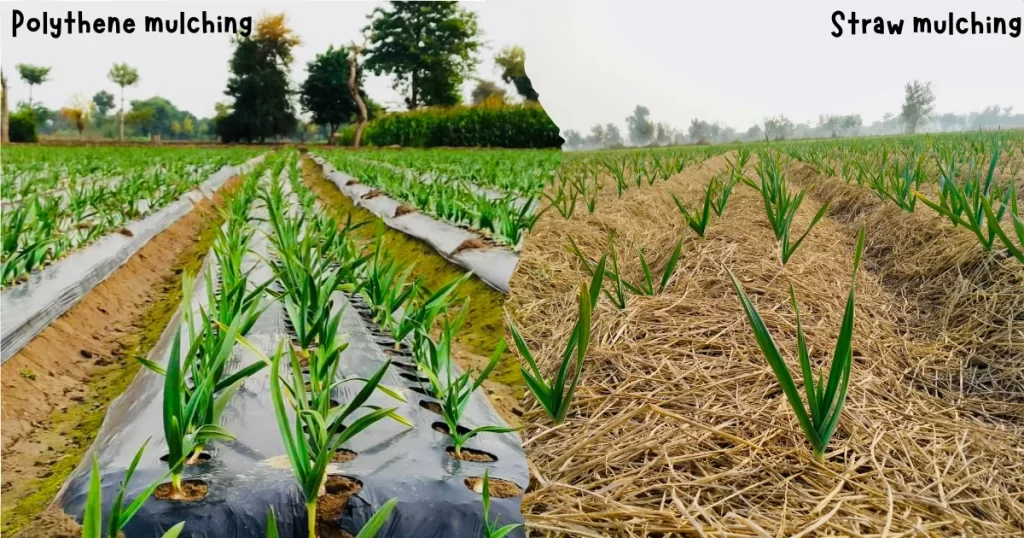
There are two methods of mulching
- Straw mulching
- Polythene mulching
Straw mulching
Straw mulching is an organic method. Which is also more beneficial for the land. We can easily mulch the straw at a low cost. Straw mulching not only controls weeds, but over time it decomposes and provides nutrients for plants. After decomposing straw, it provides potash and other micronutrients to plants, reducing our use of fertilizers. By straw mulching, we can control about 85% of weeds.
Polythene mulching
In areas where stubble cannot be easily managed, mulching of polythene is also beneficial for garlic crops. Polythene mulching is definitely a bit more expensive but the weed control is much better. Polythene can be put on the bed in less time and easily. By polythene mulching, we can control about 95% of weeds.
Use of fertilizers
After learning about garlic growing stages it is important to know how about garlic fertilizer as balanced and good fertilizer play an important role for the good growth of garlic. NPK (nitrogen, phosphorus, and potash) are those fertilizers that plants need in large quantities. While micronutrients include sulphur, zinc, boron, magnesium, iron, copper, and other components, which plants need in small quantities but they are also very important for the good growth of plants.
Use of Ash
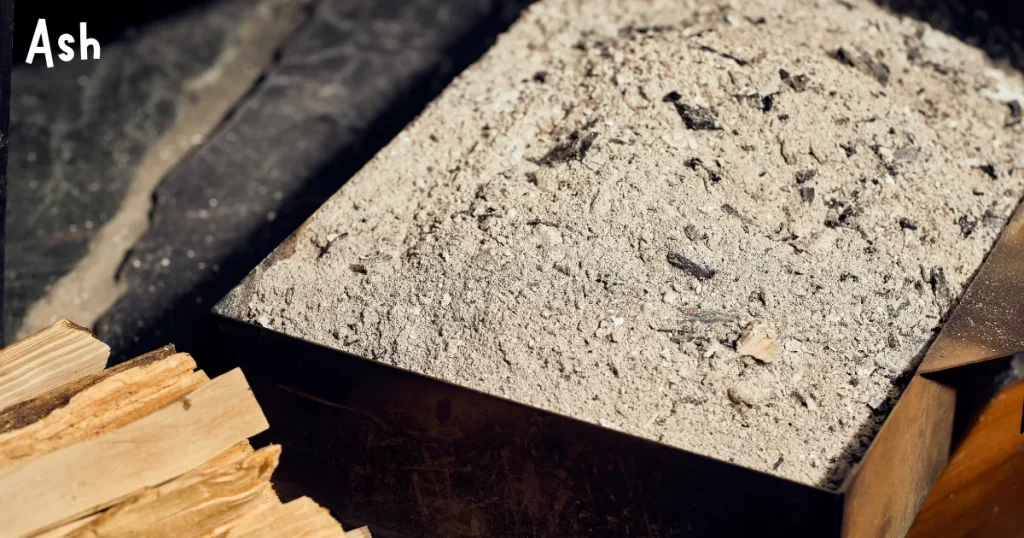
Usage of ash as a fertilizer is an old method that has been used for centuries. It boosts up garlic growth as it does just not contain potash but also has other micronutrients that are essential for the plant. It is not just used as fertilizer but also as a fungicide.
During garlic growing stages we can use two types of ash Ash of animal dung and Ash of wood. Wood ash is more beneficial for garlic than animal dung ash.In winter, when due drops are on leaves, then ash should be sprinkled, because of due drops they stay on the leaves and get nutrients from it. We can use it 2 to 3 times.
Precaution for Garlic Plants
After following the above garlic growing stages few precautions are necessary for garlic plants. Such as garlic plants need light moisture throughout the season. Remember that too much water is harmful to garlic plants. Too much water can cause yellowing of garlic leaves and can also cause fungal problems. Always water according to soil moisture. The garlic crop may also suffer from root rot in winter. To prevent root rot, flood the fungicide powder with water.
When garlic is in its final stages, it may suffer from fungal attack or blight problems. Use a good fungicide spray on it to prevent fungus. Tebuconazole and Trifloxystrobin best control the fungal attack.
Fungus Diseases Named in the following:
- White Rot (Sclerotium cepivorum)
- Neck Rot (Botrytis allii)
- Pink Root (Pyrenochaeta terrestris)
- Basal Rot (Fusarium oxysporum f. sp. cepae)
- Downy Mildew (Peronospora destructor)
- Rust (Puccinia porri)
- Stemphylium Leaf Blight (Stemphylium vesicarium)
- Fusarium Bulb Rot (Fusarium proliferatum)
Garlic does not require a lot of fertilizer. Garlic should always be given a balanced fertilizer. Complete your fertilizer schedule in the first 50 to 60 days. You can then apply a foliar spray to the garlic.
Preventing Garlic Diseases through Good Practices
Diseases like white rot and botrytis rot are big threats to garlic. Rotating crops and keeping soil dry are key steps to stop these diseases. Also, not watering from above helps keep leaves dry and reduces disease spread. Preventing diseases is just as important as treating them.
Here’s a table showing common garlic pests and diseases, along with ways to control them:
| Pests/Diseases | Identification | Control Methods |
|---|---|---|
| Garlic Borer | Small, white larvae inside stems | Use pheromone traps, encourage natural predators |
| Thrips | Tiny, winged insects on leaves | Apply organic insecticidal soaps |
| White Rot | Sclerotia (hard, black structures) on bulbs | Crop rotation, maintain dry foliage |
| Botrytis Rot | Grey mold on leaves and stems | Improve air circulation, reduce humidity |
Using these control methods and preventive steps helps keep the current crop safe. It also makes the soil better for future garlic crops. Fighting pests and diseases is not just for now but also for the future.
Garlic Scapes and Flowering
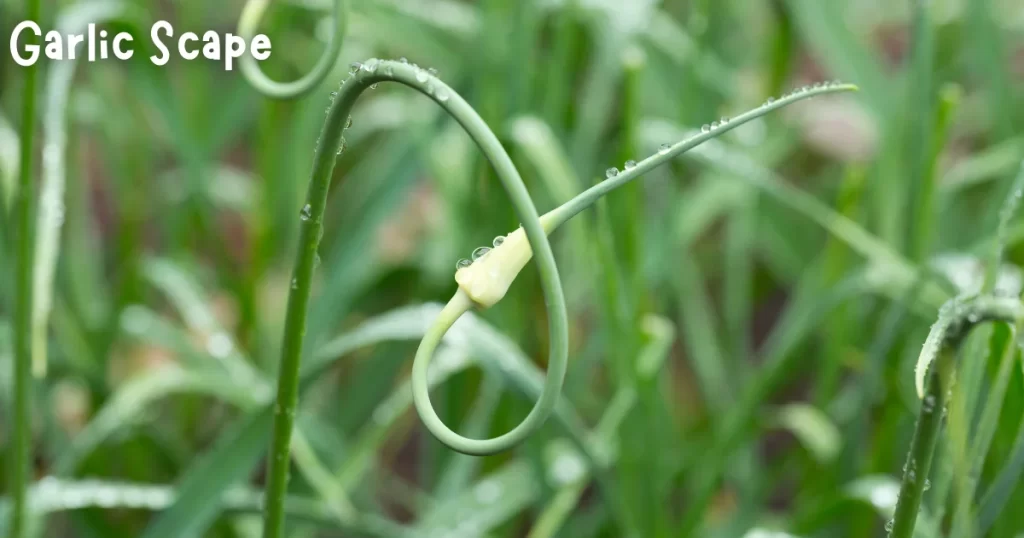
When the garlic crop is in its final stages, it produces a flower-like stem or scape at the top. After 10 to 15 days of emergence of the scape, the harvesting of garlic starts. You can also cut off the scape as soon as it emerges, cutting the scape will direct the plant’s attention to the bulb, which will allow the garlic bulb to grow larger. In some varieties, it is necessary to break the scape and in some varieties, it does not matter if the scape is not broken. You can get a delicious meal by eating garlic flowers.
Harvesting Garlic the Right Way
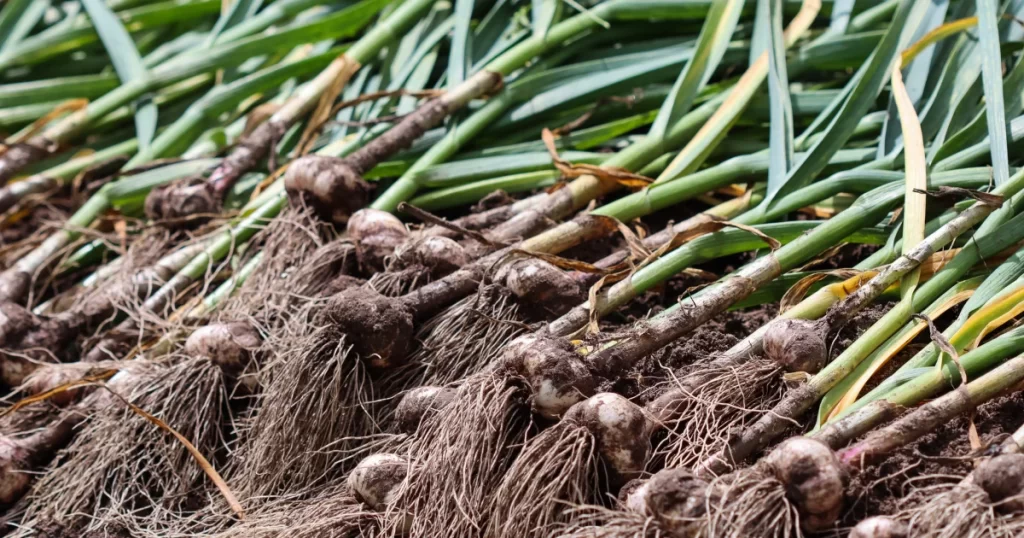
Harvesting garlic right is key to keeping bulbs intact and ready for processing. A careful approach to uprooting and post-harvest care boosts yield and quality. This ensures the garlic stays fresh and flavorful. Some types of garlic mature in 6 months and some in 9 months. Hardink garlic produces scapes in spring to indicate harvest readiness. Garlic should be harvested after 15 to 20 days of scape emergence.
Some types of garlic do not produce scapes. Harvest varieties that do not produce scapes by identifying the leaves. When the bottom 3 to 4 leaves of the garlic are brown or dry, you can harvest the garlic. But first check the maturity of the garlic bulbs by pinching a couple of plants, that the garlic bulbs have completed their maturity.
Curing and Storing Garlic for Longevity
In the garlic growing stages, the last stage is storing garlic. This is a very simple step but very important for the next 6-7 months. If garlic is not stored properly, it can deteriorate, and your hard work of the last 9 months will be wasted.
After harvesting, clean the soil from the garlic well. Never clean the garlic with water.
After cleaning, keep the garlic in a ventilated place for 15 to 20 days and dry it well. Never store garlic in a too-hot or poorly ventilated-area. After drying, the garlic stems can be tied together and hung or stored together. If space is limited, you can cut the stems after 30 days and store the garlic bulbs in a ventilated bag.
Get more information about Growing Crops:
Conclusion
Starting to grow garlic can be both rewarding and challenging. But, with the tips from this article, you can make the most of your garlic harvest. Knowing how to choose the right seed garlic and prepare the soil is key. Also, understanding how climate affects your crop is important for success.
Learning about softneck and hardneck varieties is crucial. It helps shape your entire garlic growing plan. By using the right watering methods, controlling weeds, and watching for pests and diseases, your garlic can thrive.
Knowing when to fertilize, when your garlic is ready to harvest, and how to store it is vital. Proper curing and storage extend the life of your garlic. This way, you can enjoy it for months.
By using the knowledge from this article, you’re set for success. Remember, the secret to a great garlic crop is in the details, patience, and using the best practices. As you put these tips into action, you’ll enjoy watching your garlic grow strong. And when you harvest, you’ll have flavorful bulbs to enjoy.
Let your hard work pay off in your kitchen. Enjoy the fruits of your labor and the satisfaction of growing your own garlic.
FAQ
What are the key stages in growing garlic?
Growing garlic involves several steps. First, choose the right variety. Then, prepare the soil and plant the cloves. Next, wait for sprouting and bulb formation. Finally, let the garlic mature and harvest it.
How do I choose the right garlic variety?
Decide between softneck or hardneck garlic based on your climate and cooking needs. Buy high-quality seed garlic from trusted sources for the best results.
How long does it take to grow garlic?
Garlic takes about 8-9 months to grow from planting to harvest. This time varies with the variety and climate.
What soil conditions are ideal for planting garlic?
Garlic grows best in well-drained, fertile soil with a neutral pH. Add organic matter to the soil and remove weeds to promote healthy growth.
How deep and far apart should I plant garlic cloves?
Plant garlic cloves 1-2 inches deep and 4-6 inches apart. This ensures the bulbs grow well.
When is the best time to plant garlic?
Plant garlic in the fall, a few weeks before the ground freezes. This allows for root growth before winter.
How much water does garlic need during growth?
Garlic needs consistent moisture, especially when forming bulbs. Water once a week but avoid overwatering to prevent root rot.
What are effective methods for weed management in garlic beds?
Use mulching, hand weeding, and cover crops to control weeds. Keeping the beds weed-free is crucial.
How do I choose the right fertilizer for garlic?
Use a high-nitrogen fertilizer in spring for leaf growth. Switch to a fertilizer rich in phosphorus and potassium when bulbing starts.
How can I protect my garlic from pests and diseases?
Use crop rotation and natural predators to manage pests. Good practices and regular checks help prevent disease outbreaks.
What are the signs that garlic is maturing and ready to harvest?
Look for garlic scapes on hardneck varieties and brown lower leaves. These signs indicate it’s time to harvest.
How do you know when garlic is done growing?
Garlic is ready when lower leaves turn brown and upper leaves stay green. Harvesting at the right time is key for quality.
What is the proper technique for harvesting garlic?
Loosen the soil around the bulbs and lift them gently with a fork. Be careful not to damage the bulbs.
How should garlic be cured and stored for longevity?
Dry garlic in a well-ventilated area for a few weeks. Once dry, trim the roots and store in a cool, dark place.

